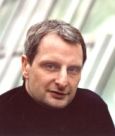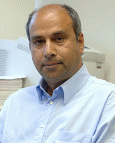PLENARY TALKS
|
|
 |
Squeezing Semantics from Media
Prof. Dr.-Ing. Thomas Sikora
Institut für Telekommunikationssysteme
Fachgebiet Nachrichtenübertragung
Technische Universität Berlin
GERMANY
more information |
|
|
 |
Human Action Recognition
Dr. Mubarak Shah
Computer Vision Lab
School of Computer Science
University of Central Florida
Orlando, FL 32816
USA
more information |
Squeezing Semantics from Media
Prof. Dr.-Ing. Thomas Sikora
Institut für Telekommunikationssysteme
Fachgebiet Nachrichtenübertragung
Technische Universität Berlin
GERMANY
Abstract:
Today, digital audiovisual applications are part of our everyday lives. It
is envisioned that powerful new and advanced applications and services
become possible based on smart content analysis and description. Of prime
importance is the extraction of semantics from images, speech, audio and
video. Worldwide efforts concentrate on bridging the gap between low level
descriptions and high level semantics. Will it be possible to design smart
applications that automatically classify and filter media - to provide
individual users with dedicated content? Will it possible to develop search
engines or specific filters that use extracted descriptions to help users or
agents search and navigate through large collections of data? In my talk I
will give an overview about the state-of-the-art in this exciting and
promising field.
About the Plenary Speaker:
Thomas Sikora is professor and director of the Communication Systems Department at Technical University Berlin, Germany.
He received the Dipl.-Ing. degree and Dr.-Ing. degree in electrical engineering from Bremen University, Germany, in 1985 and 1989 respectively. In 1990 he joined Siemens Ltd. and Monash University, Melbourne, Australia, as a project leader responsible for video compression research activities in the Australian "Universal Broadband Video Codec" consortium. Between 1994 and 2001 he was the director of the “Interactive Media” Department at Heinrich-Hertz-Institute (HHI) Berlin GmbH, Germany.
Dr. Sikora has published more than 150 papers related to audio and video processing. He has been involved in international ITU and ISO standardization activities as well as in several European research activities for a number of years. As the chairman of the ISO-MPEG video group (Moving Picture Experts Group), he was responsible for the development and standardization of the MPEG-4 and MPEG-7 video algorithms. Dr. Sikora is appointed as Research Chair for the VISNET and 3DTV European Networks of Excellence. He frequently works as an industry consultant on issues related to interactive digital audio and video. He is an appointed member of the Advisory and Supervisory board of a number of German companies and international research organizations.
Dr. Sikora is recipient of the 1996 German ITG award (German Society for Information Technology). Between 1998 and 2002 he was an Associate Editor for the IEEE Signal Processing Magazine. He currently serves as an Advisory Editor for the EURASIP Signal Processing: Image Communication journal and as Associate Editor for EURASIP Signal Processing journal. Dr. Sikora was the Editor-in-Chief of the IEEE Transactions on Circuits and Systems for Video Technology between 2002 and 2006. He is a member of ITG and a senior member of IEEE.
Plenary Speaker's web-page:
http://www.nue.tu-berlin.de/people/sikora/
Human Action Recognition
Dr. Mubarak Shah
Computer Vision Lab
School of Computer Science
University of Central Florida
Orlando, FL 32816
USA
Abstract:
Recognition of human actions from video sequences is a very active area of research in Computer Vision. An important step in any action recognition approach is the extraction of useful information form a raw video data and its subsequent representation. The representation should account for the variability that arises when arbitrary cameras capture humans performing actions.
UCF Computer Vision group has been very active in action recognition area. In this talk, I will present our action recognition work employing a variety of representations: a single point, anatomical landmark points on a human body, and complete contour of human body. We will also explicitly identify three important sources of variability: (1) viewpoint, (2) execution rate, and (3) anthropometry of actors, and propose a model of human actions that allows us to address all three. Our hypothesis is that the variability associated with the execution of an action can be closely approximated by a linear combination of action bases in joint spatio-temporal space. We demonstrate that such a model bounds the rank of a matrix of image measurements and that this bound can be used to achieve recognition of actions based only on imaged data.
About the Plenary Speaker:
Dr. Mubarak Shah, Agere Chair professor of Computer Science, and the founding director of the Computer Vision Laboratory at University of Central Florida (UCF), is a researcher in computer vision. He is a co-author of two books Video Registration (2003) and Motion-Based Recognition (1997), both by Kluwer Academic Publishers. He has worked in several areas including activity and gesture recognition, violence detection, event ontology, object tracking (fixed camera, moving camera, multiple overlapping and non-overlapping cameras), video segmentation, story and scene segmentation, view morphing, ATR, wide-baseline matching, and video registration. Dr. Shah is a fellow of IEEE, was an IEEE Distinguished Visitor speaker for 1997-2000, and is often invited to present seminars, tutorials and invited talks all over the world. He received the Harris Corporation Engineering Achievement Award in 1999, the TOKTEN awards from UNDP in 1995, 1997, and 2000; Teaching Incentive Program award in 1995 and 2003, Research Incentive Award in 2003, and IEEE Outstanding Engineering Educator Award in 1997. He is an editor of international book series on “Video Computing”; editor in chief of Machine Vision and Applications journal, and an associate editor Pattern Recognition journal. He was an associate editor of the IEEE Transactions on PAMI, and a guest editor of the special issue of International Journal of Computer Vision on Video Computing.
Plenary Speaker's web-page:
http://www.cs.ucf.edu/~vision/
|